John Wesley found little to encourage him here but he paid several visits and in 1768 writes of having preached in the chapel. This is believed to be the Independent Chapel. There seems to have existed a bond between the two Societies which continued into the next century. The earliest Methodist meeting place was in a stable at the back of a Market Place shop. The animal noises which accompanied the service must have been distracting. It was a very dark and run-down place but the warmth of the fellowship made up for a few minor discomforts. The membership in those days (mid 19th century) was small, and composed mainly of domestic servants with a sprinkling of local residents. The butler and housekeeper at nearby Park Place were among the congregation and contributed generously to the building fund, the latter having donated a sovereign given to her by Queen Victoria and the greater part of a legacy from her late employer. The Minty family were once again generous benefactors to the cause and Mrs. Minty laid the foundation stone of the chapel on 21st July 1873.
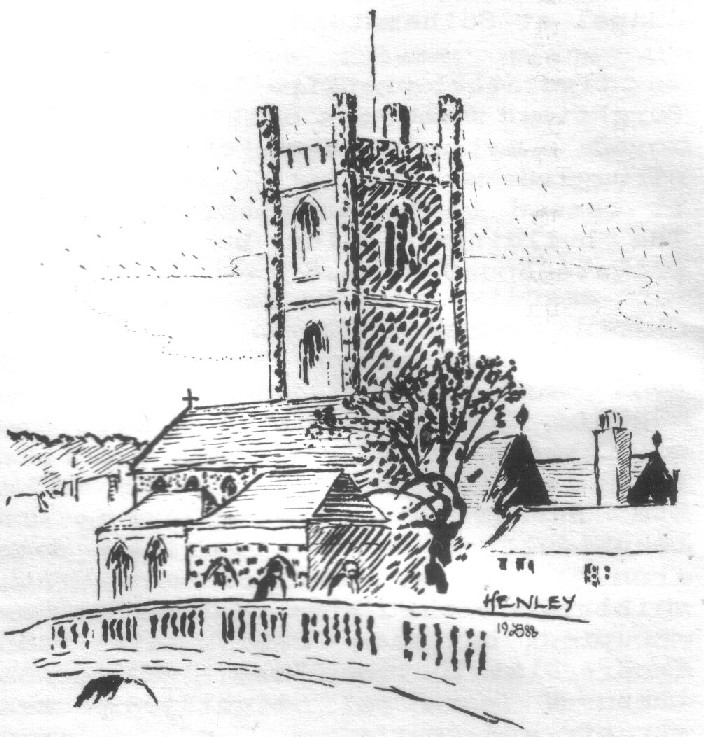
During those early years the Society contributed much to the cultural life of the town. A Wesleyan Methodist Musical Society of 30 voices was formed, and also a Mutual Improvement Association, which held regular lectures on cultural subjects – famous people, travel, etc. Several Societies in the Circuit held Mutual Improvement events and probably out of these grew support for the Wesley Guild. The nonconformist churches of Henley for some years held joint Watchnight services on New Year’s Eve.
In 1897 the debt on the building was discharged and in the following year some renovations were put in hand and the church was given a good spring clean. The cost, £110, was met by a ‘Gipsy Encampment Bazaar’ held in Mr Wm. Hamilton’s meadow. In 1899 we find the first reference to an inter-church football match with Wesley, which Henley won 2-0. In 1904 the schoolroom and vestries were provided.
Now the building is gone and a row of smart shops is in its place. The small congregation has moved to the parish church of St. Mary, an ecumenical venture which has met with success and which would have gladdened our Founder’s heart could he return to Henley today. We should perhaps pause to reflect on the dedication of local preachers who throughout many years, until the advent of the car and local ‘bus, walked the eight miles from reading to Henley in all weathers. On one occasion, when in a Local Preachers’ meeting the Superintendent Minister proposed that the cause at Henley should be given up, the local preachers unanimously rejected the proposal and the work continued.
[Meetings stopped 2003]
Little information is available, but we know that friends of the Hosier Street, Reading, Free Methodist Church, built a church and maintained it for 30 years. It was transferred at a nominal price to the Wesleyans and played its part in the life of the Circuit until, in December 1920, the last services were held and it closed in 1921.
In the early 1930s the Tilehurst friends began holding meetings at the bottom of Kentwood Hill and it soon became apparent that a church in that area was needed. Mr. Arthur Newbery, a Methodist and generous benefactor to the Reading Circuit, living nearby, gave land for the building of Kentwood Church which was opened 1937 and has maintained a devoted witness in that part of Tilehurst until the present day. In that growing area it has great potential. On Saturday 12th September 1987 Kentwood celebrated their Golden Jubilee with a garden party, and with a service of thanksgiving on the following day. [Church since closed]

Sulhamstead and Swallowfield, together with Twyford, were lost to the circuit in 1850 by the ‘Reform Movement’ but Twyford returned to the fold and the wounds of dissension were healed.
Mr. Bromley, a Wesleyan of long standing, opened his house for worship until the first chapel was built in 1860. Having been built over a pond its life was of brief duration as dry rot set in. The foundation stone of the present building was laid in 1876 by Mrs. James Dymore Brown.
Although so near to Reading, Three Mile Cross has preserved its individuality and is still very much a village church. The town churches have always been willing to offer support and have accepted hospitality on many occasions. [Church since closed]

Built in 1849 and at first a struggling cause, by the end of the first decade it was regarded as the most rewarding country place in the Reading Circuit. Indeed, at the Harvest Festival of 1894 so many came that the chapel was filled to the doors and many were unable to gain admission and fifty-two people remained behind for a prayer meeting. There was a large and flourishing Sunday School, and a excellent choir which was reorganised in 1897 when a presentation was made to the organist. At the weeknight meeting of the Missions Anniversary in 1898, at which lantern slides of Guiana were shown, tickets had to be issued in order to prevent overcrowding. In spite of all this promise there was a gradual decline in membership and the end came in 1915,
Towards the end of the 19th century a vast, new housing estate was being built at the west end of Reading on a site, which was formerly the estate of Alderman Hill, known as Elm Park. It was felt that a Methodist witness in the area was needed and a former Salvation Army Hall in Elm Park Road was acquired for 12 shillings per week rental. From 1901 services were held here, and in the open air, until a more permanent building could be erected. In the first year 200 scholars attended the Sunday School. The summer treat to Moatlands Farm, Trash Green, when visitors were conveyed by motor car, was a huge success. The Band of Hope, too, was thriving.
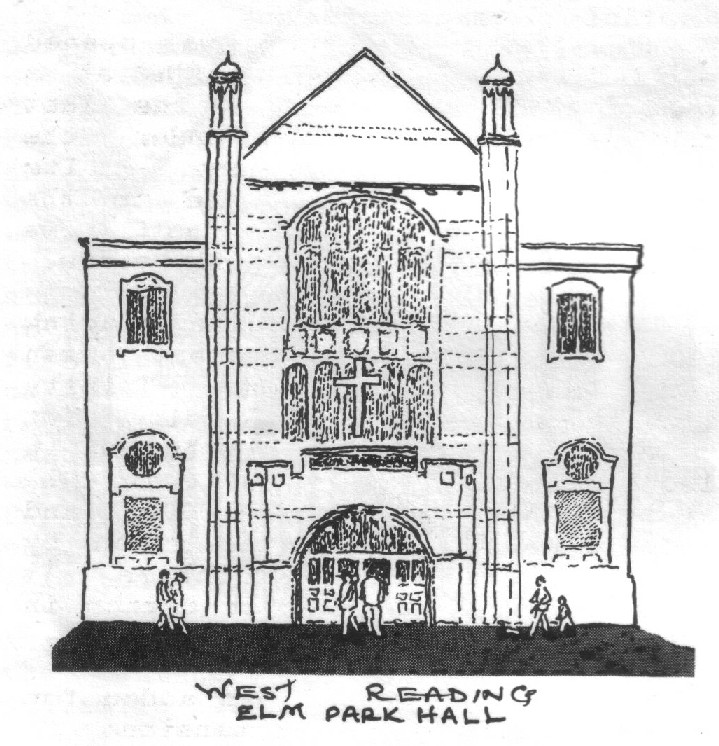
On 22nd June 1904 the stonelaying ceremony for the new hall was well supported by the Circuit. Mr. G. G. Gilligan, a generous benefactor to Wesley and Oxford Road, Donated £1000 and other friends gave their gifts as stones were laid. Forty children from around the Circuit (and we know their names) laid bricks. The entire cost of the building was to be £6500. On 1st February 1905 the new building, known as Elm Park Hall Wesleyan Mission, was opened by the President of Conference, the Reverend Sylvester Whitehead, in front of a full Church. The main hall, accommodating 1000, was on the first floor with its gallery and choir rostrum, whilst the lower hall was used for Sunday School and youth work, and, during the 1914-18 war, as a day school. The massive organ commemorated those who gave their lives in the 1914-18 war.
A feature of the early years was the Elm Park Pleasant Sunday Afternoon, with its own orchestra and much support from the men and women on the fringe of the church activities. P.S.A. outings by river and rail were publicised in the local pres, such was their popularity. In later years, bazaars and eisteddfodau continued to attract local talent and support and provided funds and maintained the social life of the church. Music had always been a feature of the Life of Elm Park Hall.
[Church subsequently closed and demolished, the congregation joined Emmanuel.]
(Now more usually known as Gosbrook Road.) Separated from Reading by the River Thames, Caversham must have enjoyed a quiet rural atmosphere when Methodist cottage meetings begin in the mid 19th century. In fine weather the congregation took to the open air and thus were able to make contact with a wider public. In August 1881 the foundation stones of the first building, an iron chapel, were laid and the work took on a more permanent basis. At the Quarterly Meeting of December 1893 a most profitable and stimulating conversation on the work of God took place and in particular on the special mission services in Caversham – ‘the blessed influence felt at the prayer meetings, preaching services, and in the Sunday School.’
The Society had a good friend in Mr. H. C. Bound, a member of Church Street, and later of Oxford Road, who, with members of the latter Society, gave help and encouragement to the Caversham friends during their early years as a Society. In gratitude for his help both spiritual and financial, especially to the Sunday School, a tablet in memory of Mr. Bound was placed in the schoolroom and survives to this day. The one placed in his own church at Oxford Road does not! The schoolroom, which also served as a church until the present building was erected, was built in 1891.
In 1898 the stonelaying for the new chapel took place and on 11th January 1899 it was opened. Thanks to another good friend of Oxford Road and Caversham, Mr. John Minty, and gifts at the stonelaying, the new building opened almost free of debt.
A string band, which for some years had accompanied the singing, continued to do so, and the new organ was installed in March 1903. At circuit events the Caversham string band and Spring Gardens Band often joined forces and must have made a useful contribution to events in the open air.
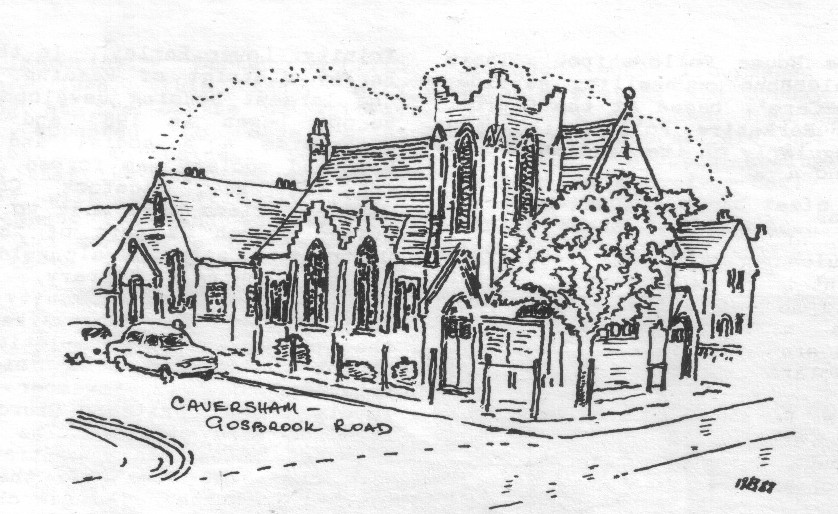
The church, with its spire, was a handsome building, but, unfortunately, the spire became unsafe and had to be removed in 1958. Then, several years later, the weight of the roof caused the walls to bulge and much restoration work became necessary. The work was costly, but by a determined effort, the bills were paid. Financial help came, unexpectedly, from friends in distant places. A ministerial exchange between the Reverend Ralph Rogerson and the Reverend Herbert Glenn had forged a link of friendship between the two societies and the American friends made a generous donation to the Caversham rebuilding fund of £1200. The result is a beautified sanctuary, light and attractive, enabling this devoted and dedicated community to maintain a faithful witness and to serve the needs of Caversham into the 21st century. Perhaps the greatest contribution to the life of the community is the work among young people in Brigades and Sunday School, and among women. To commemorate the centenary of Gosbrook Road a booklet giving background information of the village of Caversham in 1881 and the place of the church in it, and a description of today’s activities, was issued in 1981.
At a Circuit meeting in 1900 it was decided that a Wesleyan church was to be erected on a site on Warren Hill, Caversham. The plot of land was given by Mr. J. C. Fidler and the church was opened on Wednesday 23rd June 1909 at a cost of £2000; it was the last church to be built under the Wesleyan Extension Scheme. Its membership was 25 and due to the sparse population did not rise beyond 100 for the next fifty years.
An American organ led the singing until 1913 when the present organ was purchased from Trinity Congregational Church, Reading, for £100. The organ was overhauled in 1959 and completely rebuilt in 1981 at a cost of £25000, and rededicated at a recital given by the late Dr. W. S. Lloyd Webber. It is one of the finest organs in the area.
In 1929 a lecture hall was added for £1000, followed by extensions in 1959 and 1974 and a new kitchen was fitted in 1986. Alongside the building programme of the last fifty years there has been growth in it membership to the present 275, and in its influence in the community. It has set out to be a neighbourhood church caring for and serving the people of the area and at the same time having a missionary zeal. The youth work has flourished through its Sunday School and Squash, and in the variety of uniformed organisations, playgroups and Mother and Toddler groups. There are now two women’s organisations meeting the needs of all ages. In recent years a success has been the Caversham Heights Society, arising out of the Wesley Guild, and now having a membership of 200. The elderly are cared for through the ‘Stay-a-While’ (a luncheon club) and ‘Out-a-While’ (which takes members out on visits). The spiritual needs are met through two Prayer Groups and five House Fellowships. There is a telephone counselling service, ‘Share-a-Care’, based at the church, and the Berkshire Polio Fellowship meets regularly on its premises.
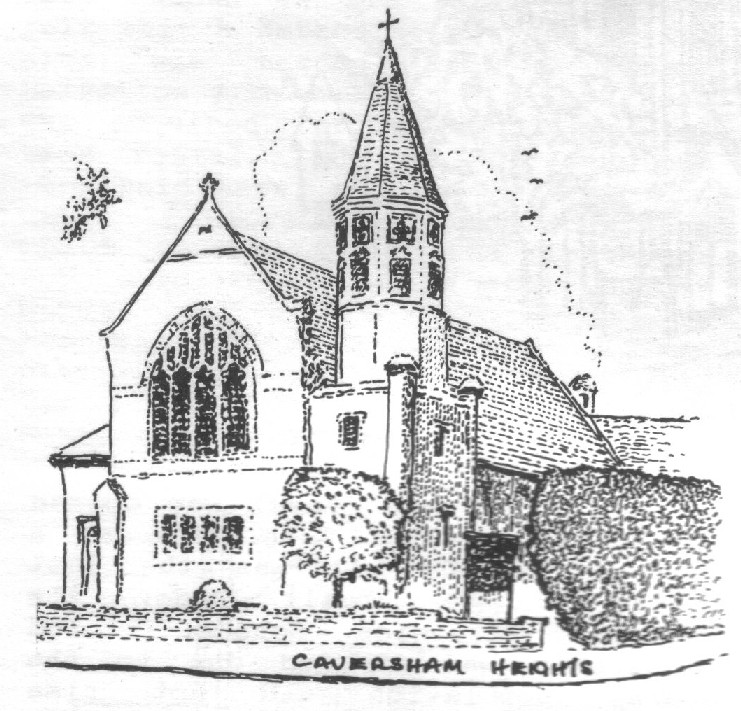
Like many of its predecessors in the Reading area, the Society began its life in the home of one of its first members. In 1956 a small group met together for worship and decided that a Methodist Church was needed in this growing area. The Atomic Weapons Research Establishment attracted a great number of workers, a housing estate grew up, and with it the Methodist Church in Newchurch Road. The attractive layout is in the form of a square with the Manse on one side, the church and hall adjoining and a central courtyard garden. As a Society of young families, work among children and young people predominates, and continues with Women’s Fellowship and other activities. In 1982, Tadley Common celebrated its 25th anniversary with ten days of celebration and visits from former ministers.
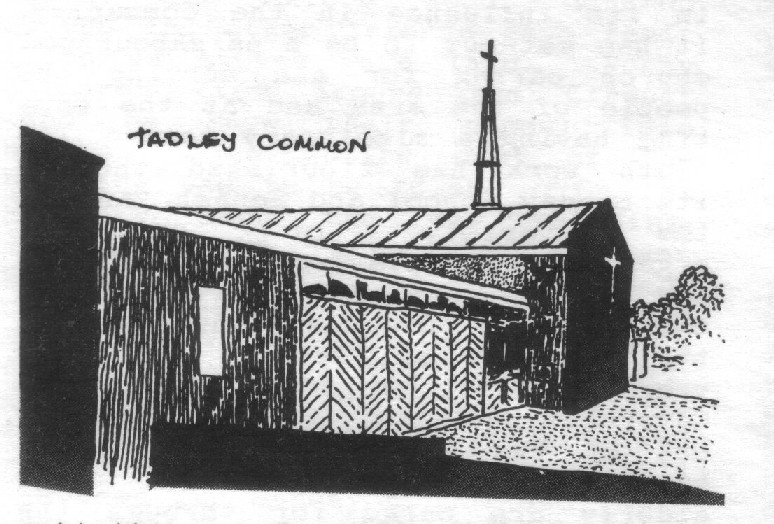
In the Lower Earley district of Reading, one of the largest housing developments in Europe began in 1983 and shortly afterwards a Methodist and United Reformed society was formed, meeting in the new Radstock Community Centre. Plans were made to build a united church as part of the large District Centre, alongside the health centre, library, leisure complex, youth and community centre, public house and supermarket. As the plans neared completion, the Church of England also joined the scheme and on 7th November 1987 a lovely new United Church and premises were opened. The cost of £340000 makes a stark contrast with the cost of some of the early circuit churches. The new church is called ‘Trinity’, with a joint church council of Anglicans, Methodists and United Reformed members, and with a shared ministry of ministers from each denomination. It seats 250 people, and is already full on most Sunday mornings, its membership having risen to over 100.
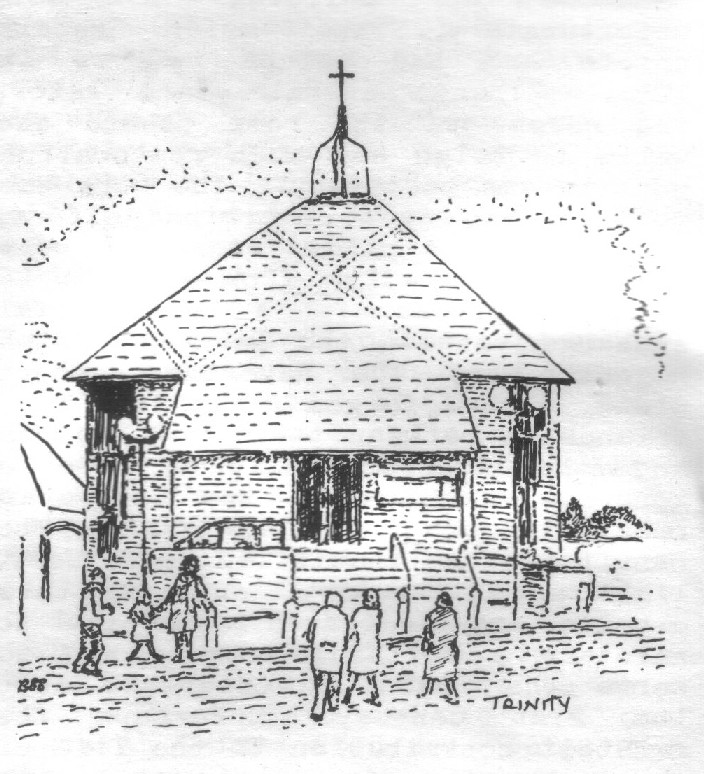
This cause grew out of an independent mission, first becoming a class of the Wokingham Society, having a good Sunday School, and acquiring its independence within Reading Circuit in 1982. It was, however, closed in July 1985. [Later demolished]
Opened on 11th December 1948, this neat, airy building at the centre of Whitley Estate appeared to have a great potential. A resident Deaconess ensured that the local people could identify with the friendly figure living among them and working with them. And so, for a few years, it proved to be. The Sunday School and Brigades work flourished and the Women’s meeting and Sunday Services were well attended. No one really knows why Bourne did not succeed, but people stopped coming and the vandals took over. Sadly, the end came in 1980, but one feels that the church needs to be present in such areas.
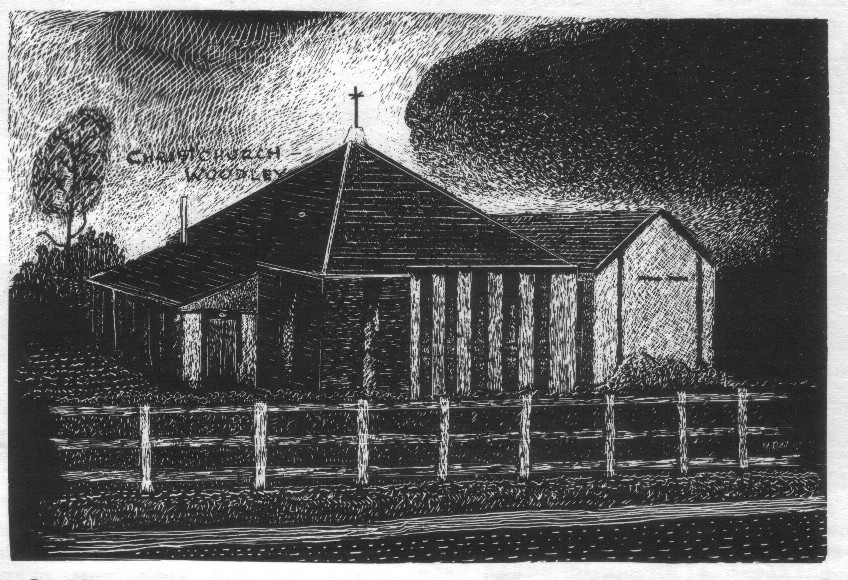
In the post war years when Woodley gradually lost its identity as a Berkshire village and became a suburb of greater Reading, a Methodist witness began to take shape and those professional and business people who had settled in the area looked around for a meeting place. Services were held at first in Coronation Hall, but it soon became imperative that a more permanent building should be acquired. In 1963 that became a reality when the Circuit had the foresight to acquire a large site with room for expansion, and within a few years the number of members had outgrown the premises and further expansion became necessary. Ultimately a new Church had to be built and at the same time an amalgamation of the Methodist and United Reformed Churches was effected [1982]. A modern, airy building, with large windows open to the passing world, has replaced the dark original church and has provided further scope for numerous activities among the nearby residents.